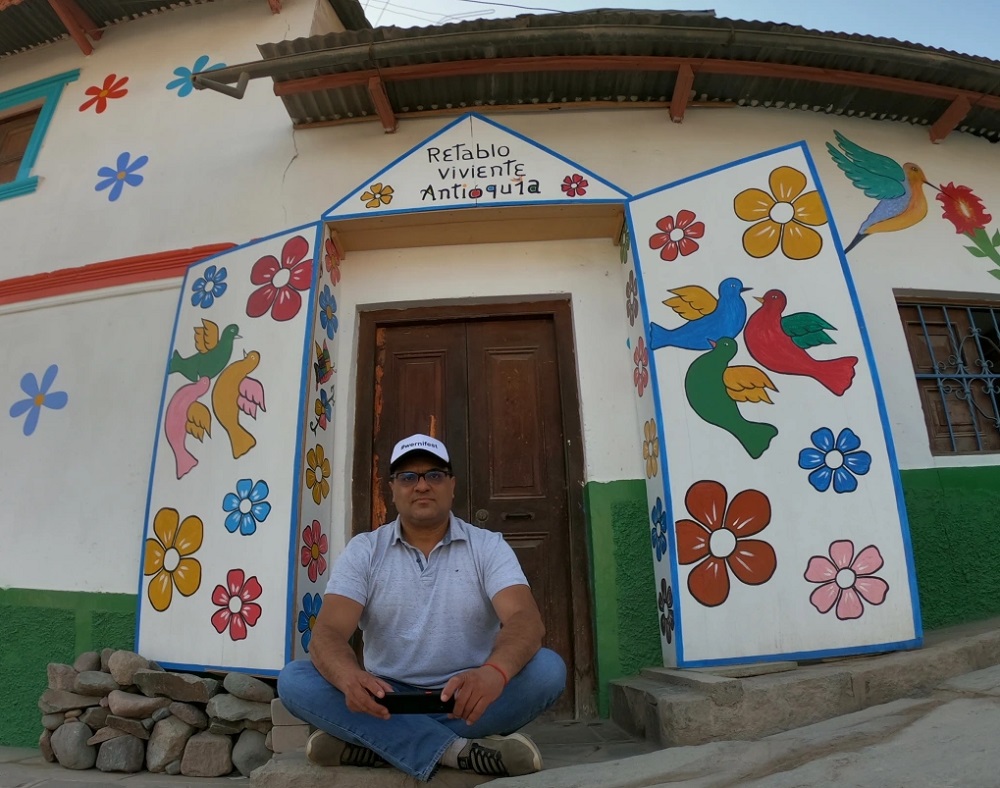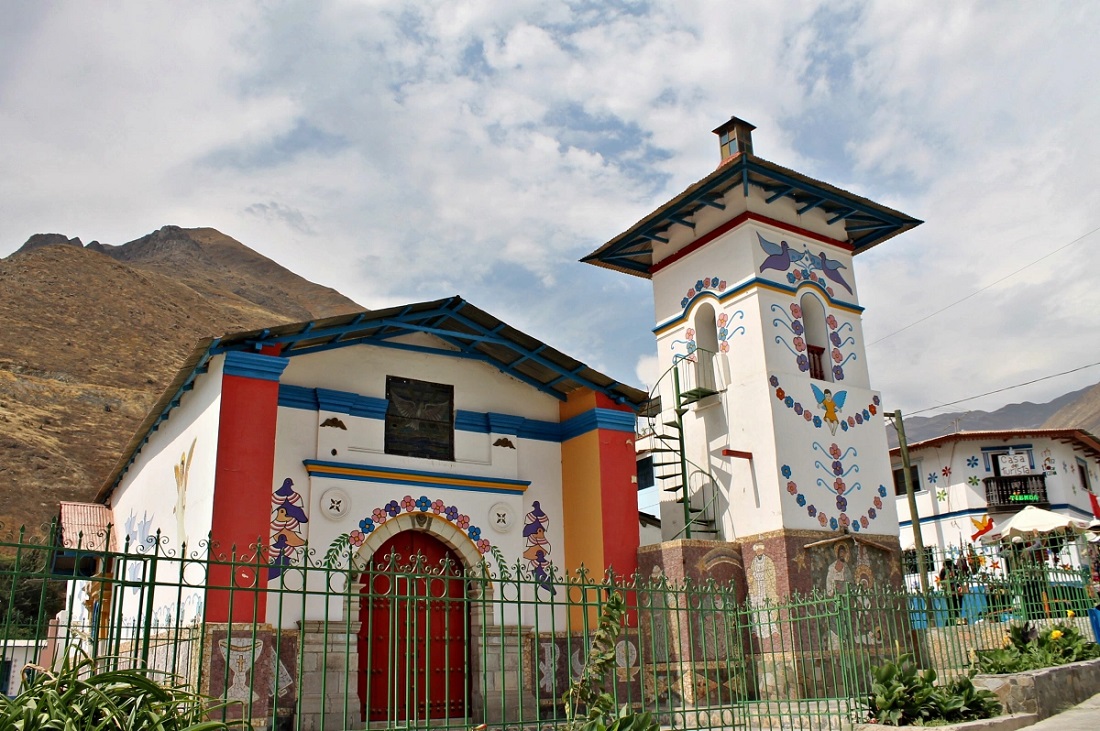Close your eyes and imagine that you are walking through streets full of colour. Where houses with angels, flowers and animals painted on their facades welcome you. Now you can open them, you're in Antioquia.
Antioquía is a small and peaceful town located between the hills of the province of Huarochirí, only 70 km. from Lima. It is also known among its inhabitants as the Espíritu Santo town. This magical corner of Peru is known for having buildings with very cheerful and colorful fronts. That is why they also call it "colored town".
Among the diverse figures that one can appreciate within its walls are flowers, farm animals, and buildings. The town is ideal for exercising your imagination and, incidentally, for taking beautiful selfies with these works of art in the background. The best season to take advantage of the splendid Antioquia sun is between April and December. Thousands of visitors find the perfect photo thanks to the impressive daylight.
The Land of Colors
The history of Antioquia is an example of creativity to boost the economic growth of the town. In the 1990s, the Center for Research, Education and Development (CIED) was working to promote agricultural development in the area, when it realized they needed to do something bigger.
Therefore, in 2003, they set themselves the goal of attracting more visitors through tourism. In this way, the “Colors for Antioquia” project was born, with which they literally transformed this town into an art gallery. The first step was to raise awareness among the population through plastic arts workshops, with experts who instructed the families of the town. Then, an international contest was held to choose the artistic design that the district would carry. The Peruvian painter Enrique Bustamente was the winner. Thus, in 2004, the artist painted Antioquia. He started with the schools, the church, the community hall, and continued with the houses and various public spaces.
Likewise, as part of the economic development initiative, the inhabitants of Antioquia were trained in tourist services, in order to turn the town into an attractive destination for travelers. And yes they did amazing!

Where is Antioquia?
Antioquía is located 76 kilometers from the center of Lima, in the province of Huarochirí and at about 1,500 meters above sea level. This district was founded in 1935 and its capital is the town of Espíritu Santo.
How to get to Antioquia from Lima?
You can get to Antioquia by car or your own transportation, take the route to Cieneguilla in the direction of La Molina and continue directly to the province of Huarochirí; or take one of the buses that leave from the intersection of Nicolás Arriola and Rosa Toro avenues, in San Luis. You can also sign up for a full day tour of this magnificent destination. The duration of the trip is about three hours.
Weather in Antioquia
One of the best things about Antioquia is its climate, warm for most of the year. The best time to visit this charming town is between April and December, when the temperature usually averages 22°C.
Tourist places of Antioquia
Here is a list of the best places you can visit in the Antioquia district for a tour full of unforgettable experiences:
Holy Spirit Church
The central temple of the town of Espíritu Santo offers perhaps some of the most memorable postcards of the place, with its façade full of Andean and multicolored designs. This church has small altars inside with golden motifs and a main altar with a large altarpiece.

Local Museum of Antioquia
Near the Plaza de Armas you can also find a small but interesting museum with ceramics, utensils and ancient tools, samples of plants and animals, and even mummies.
Cerrito de Amancaes Viewpoint
One of the two viewpoints that Antioquia has. You can go up to it from the city, admire the colorful houses along the way and, once at the top, enjoy an unbeatable view of the picturesque town and the green valley that surrounds it.
Cochahuayco
The town of Santiago de Cochahuayco is located 3 kilometers from the populated center of Espíritu Santo. You can visit the beautiful Temple of Santiago de Cochahuayco, declared Cultural Heritage of the Nation, as well as the Processing Plant that offers a tour to learn about the agribusiness of the area.
Qhapaq Ñan
In the Santa Rosa de Chontay area you can find one of the best preserved segments of the Xauxa-Pachacamac section of the Inca trail or Qhapaq Ñan. On it you can go trekking and admire the landscape.
Lurin River
In the area you can also find this river surrounded by greenery. The pools on its shores are ideal for taking a refreshing bath, as long as the waters are calm.
Archaeological site of Snow Snow
Near the small town of San José de Nieve Nieve is this archaeological site that houses houses from the Inca period and even a cemetery. This town also boasts a beautiful stained-glass church and a lookout for incredible panoramic views.
What to do in Antioquia?
I love its tranquility, the only thing I miss is the internet connection that is very limited (the cell phone signal does not reach well), something that I think has already been solved.
You can go on your own or on a full day tour. There are six things that I recommend you do in Antioquia, and if you want to do them all, you need more than one day:
Walk through the town towards the viewpoint:
Beginning with its parade ground, the church, the community hall, the school and going up to the viewpoint. Along the way, you will see the houses decorated with murals. Now it has two viewpoints.
Visit the Antioquia museum
Small museum with ceramics, utensils and tools. They can also find 2 mummies, among other accessories. The entrance costs 3 soles per adult, children do not pay.
Visit Cochahuayco
Cochahuayco is another very quiet town just 2.5 km from Espiritu Santo de Antioquia. It has a 17th century church and a small apple and quince jam production plant, which I hope is still running.
Bathe in the Lurín river pool
As long as the river is not too fast. After the walk and the intense sun, we refresh ourselves in the river. The only drawback were the mosquitoes.
Trekking through the Qhapac Ñan (Inca trail):
The best of Antioquia! I have done the hike twice and loved it. The trekking begins in Cochahuayco, bordering the hills, following a stretch of the Inca trail that linked Pariacaca with Pachacamac. You go through some tambos, a desert landscape with very peculiar cacti, you cross the river in Oroya and you reach Antioquia.
It's an easy hike but it takes three to four hours, depending on your pace and stops. I recommend starting it before 11 am.
Delight yourself with Antioquia sweets.
The pumpkin mazamorra that the ladies in the Plaza de Espíritu Santo sell is one of the richest I've ever tried.
Jams and quince and guava nectars. Be sure to take home a pair.
Handmade ice creams
Full day to Antioquia
Here is a full day tour of Civiatis that, in addition to Antioquia, includes Cieneguilla and Nieve Nieve, which are on the way.

Where to eat?
There are several restaurants. For a menu you can go to the Parco restaurant, next to the bus stop. Every time I've eaten there, it's been good and well priced. They also serve à la carte dishes and if it is in season, some good shrimp.
Antioquia Restaurants
In Antioquía you can find restaurants with delicious food and drinks made with local products: spicy guinea pig, shrimp chupe, pumpkin mazamorra and quince soda.
Why were the houses painted with murals?
I really believe that the history of Antioquia is a very creative example of how to promote the local economy, which was based on agriculture, with apples as its main product, towards other sectors. Since the 1990s, the CIED (Center for Research, Education and Development) has worked promoting agricultural development and agro-industrial products; however they needed to reach a broader market. For this reason, in 2003, they proposed the strategy of attracting visitors by developing their tourist offer. This is how the project “Colors for Antioquia” arose, to turn it into a work of art.
The first step was to sensitize the population, with plastic arts workshops for adults and children, and with an Art Symposium. They summoned several plastic artists, who lived with families from the town, to later paint pictures related to local identity and exhibit them in a gallery in Antioquia.
The second step was an international contest to choose the artistic design that would be painted in the town, the winner being the Peruvian painter Enrique Bustamante.
Finally, Antioquia was painted in 2004, starting with the school, the church, the communal area and the renovation of the facades. Rafo León in his Guide to the Lima Region mentions that initially some residents were reluctant to paint their facades, because the colors (pink, blue, yellow and lilac) were "very mountainous." Over time they joined the initiative and to date you can see beautiful murals in most houses.
Best Tours in Peru
Many are the routes that take you to Machu Picchu, but none is like the Inca Trail Tours, the most famous pedestrian path in the Americas. After flying from the capital of Perú, Lima, you will arrive in Cusco to walk for four days along a path through forests and dense fog, millenary stone steps and discovering the ruins of ancient fortifications and Inca cities, and all the time enjoying majestic views.
- Salcantay Trek Peru to Machu Picchu 5 days
- Palcoyo Mountain Tour
- Cusco to Manu Tour
- Humantay Lake Day Trip
- Huchuy Qosqo Day Hike
- Half Day Cusco City Tour
- Llactapata Inca Trail to Machu Picchu
- Qoyllur Riti Festival
- Apurimac River Rafting
- Vilcabamba Trek to Machu Picchu
- Inti Raymi and Machu Picchu Tour
- Salkantay Inca Trail Combo
- Waqrapukara Peru Full Day Tour
If you want to visit Machu Picchu, we recommend you to book your Machu Picchu Ticket in advance, so you will enjoy your Vacation in Machu Picchu without any problem.






